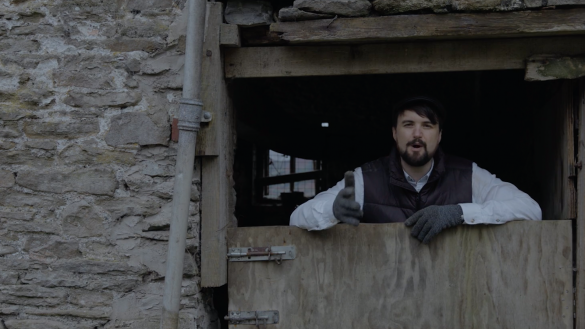So, chances are you’ve been working your way through our interactive Eden resource and now you want to have a go at getting creative yourself? Maybe you’re after a bit of creative direction?
You’ve come to the right place!
In this section, Dai has suggested a couple of poetic templates that you can use to frame your creativity, along with a written example based on said templates. Below find a template and example for
Writing a psalm is an opportunity to creatively respond to God through poetry. I’ve written a stanza that personally reflects each section of the Eden story. Try using the same 4-part structure by adding to your poem under each heading. A key tip for writing a psalm would be to make it relational. I’ve repeated words throughout like ‘you’ and ‘me’ - to highlight who God is, what he’s done and how that has impacted me. Ending each line on ‘you’ or ‘me’ also helps building with rhyme and rhythm. (I find that ‘me’ is a great rhyming word - e.g. Calvary, majesty, you’ve set me ‘free’- but you can also repeat it and change the verb that precedes it - e.g. you know me and hold me).
God – you created me
You knitted me
intricately.
You don’t need an app to find me
and you also remind me that
before I knew you, you fully knew me.
God – I was broken
I messed up
but now I’m fessing up
to the fact that I can’t do this life stuff
without you.
God – you restored me
You rescued and redeemed me
’cos Jesus laid his life down at Calvary.
It changed the fate of humanity,
and by choosing you, Lord,
I can say with clarity
and with no hint of vanity
that because of you…
God – I’m a new creation.
And you are owing the standing ovation
’cos you know me and hold me
and hold together all creation –
your creation – heaven and earth,
but minus the broken bits.
Full on restoration.
You’re making me new.
You’re making all things new.
You can use the same 4-beat structure of Eden – creation, fall, redemption, new creation – to storytell Scripture. Another option is to unpack this further by following the 6 beats through ‘the drama of Scripture’. Try using the following alliteration of ‘C’ to tell the story. I’ve included my stab at it to give you a sense of what this could look like.
Creation… (Where it all started)
Gen 1.1 – ‘In the beginning God…’
The story starts with…
God – created the heavens and the earth.
From plants to planets, mice to mountains…
out of the nothing, God created the something.
And the pinnacle of his creation was you and me,
image bearers, God reflectors.
The very first you and me – Adam and Eve –
strolled through a garden in constant company with the creator… God.
Crisis… (The fall)
But then, crisis – it all goes Pete Tong, wrong.
The serpent deceives Adam and Eve.
With the world’s freshest fruit at their fingertips, they take a bite from the tree that’s off limits.
The result? They get a taste of mess, pain and brokenness.
They’re separated from the God they were made to reflect.
Everything’s changed.
But in the pit of the pain, there’s a promise – Genesis 3.15. A serpent striker, one man, will rectify and reconcile.
One man will beat the brokenness by becoming broken for us.
Chosen… (The story of Israel starting with the call of Abraham)
Flip forward to Genesis 12.2. God choosesFather Abraham, and his family become achosen people–
Israel – a nation that God chooses to reveal himself to the world.
God sets up laws, tabernacles and temples,
puts judges and kings in charge
and picks prophets to keep the nation on track.
But a constant cycle of disobedience and repentance, followed by God’s patience and forgiveness.
Israel divides,
gets conquered.
The cycle continues…
and the chosen people wait for the promise…
Christ… (Life, death, resurrection, ascension)
… Of the chosen one (some 400 years later)… Christ – Son of God.
He chose…
a manger over a mansion,
a colt over a chariot,
serving over status,
a crown of thorns over a crown of gold.
He chose the cross for us…
John 19.30 – it.is.finished.
The crisis has been carried,
penalty paid for.
Christ dies… but the twist in the story –
three days later the tomb’s empty.
Christ resurrects to life and the payment for sin clears.
Church… (This starts in Acts, but we’re part of the story too)
Jesus sends his spirit at Pentecost and followers of Jesus become…
the Church.
(1 Peter 2.9). A royal priesthood, a chosen people,
offspring of Abraham adopted into the family of God, reflecting Christ.
And it doesn’t end in Acts. The chapter’s unfinished…
it’s still going today – 2,000 years later, in every corner of the globe –
and this is where we fit into the story.
Completion… (New creation, seen through the eyes of John in Revelation)
But the story hasn’t finished…
One day the promise will come to completion.
John gets a revelation of how the journey ends –
Revelation 21 – a new heaven and earth.
No more pain, no more tears.
A place where full restoration will be the final destination.
For the psalm piece stanza, ‘God you Restored me’, I begin with the alliteration of the same letter ‘R’ – Rescued and Redeemed. I’ve highlighted in red some sections where I’ve used alliteration in both creative examples.
For the psalm piece stanza ‘God you created me’, I’ve taken some inspiration from Psalm 139 which I’ve highlighted in blue (particularly verses 7 and 13).
For ‘I was broken’, I’ve rhymed ‘messed up’, ‘fessing up’ and ‘life stuff’. ‘Stuff’ is not a full rhyme but it has a similar punchy sound and, if delivered intentionally, it can be emphasised.
A big part of my process as I write is to speak the words out. Often you know what works and what doesn’t just by how the words you’ve written sound together. This is especially important if you’re planning to perform your poetry. You can also work on emphasising certain syllables to carry rhymes and hear how the rhythm sounds too. Are there too many syllables? Does it feel clunky? Are rhymes getting lost?
In the Christ section of the 6 Cs, I’ve intentionally tried to rhythmically build when describing Jesus. I’ve done this through alliteration, to creatively share how he gave up his status to change ours (e.g. he chose a manger over a mansion, serving over status). If you feel there’s something significant you want to communicate, try saying the same thing in different ways.
Similarly, in the creation section of the 6 Cs, I’ve tried to paint a picture with words of how God created creation, rather than just simply stating it.
‘Mice to mountains’: I’ve repeated the pattern of small things (mice) to big things (mountains), to try and share the spectrum of God’s creation. You may also notice I’ve used a rhythm of one syllable, then two syllables, along with more alliteration – in this case the letter ‘M’).

Storytelling scripture through spoken word - a free resource to share and screen.

Check out these spoken word films by poet Dai Woolridge, creatively bringing the Bible to life.

The 'journey through the Bible in 3½ minutes' series
It's a big book – and as well as being a library, it's also it's own story. We've broken that big tale down into three parts, all 3.5 minutes long.